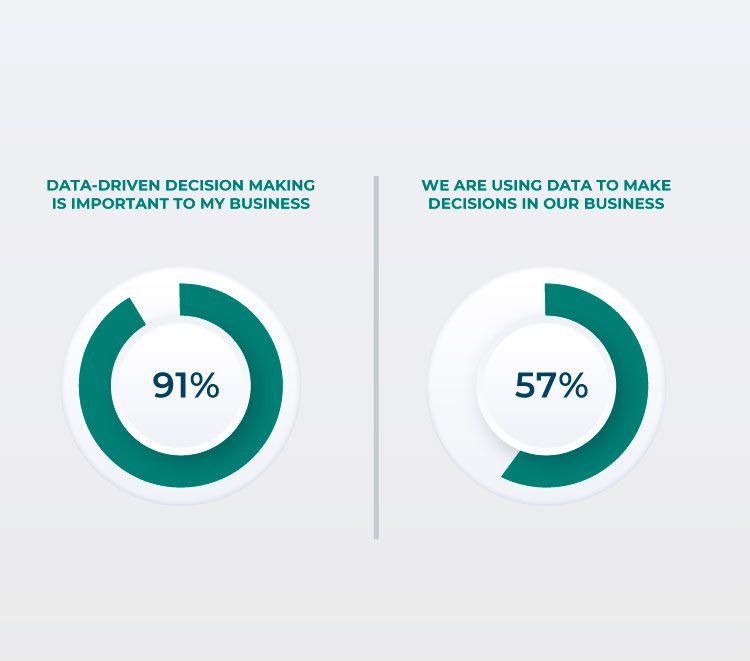Data is being collected and stored now more than ever by organizations. According to a study by BI-Survey, 91% of organizations surveyed stated that data-driven decision-making was essential to their business, while 57% stated that they use data to make business decisions.

mage source: superoffice.com
While this data can improve decision-making and business processes, it also has the potential to be a liability if not managed carefully. To protect customers’ privacy, follow the most recent privacy laws, and use data insights to improve competitiveness, data analytics companies need to put in place a data governance framework that does more than manage data quality at a basic level.
Data governance is the process of managing data the entire data lifecycle from collection to disposal. This includes establishing policies and procedures for data usage, assigning roles and responsibilities related to data management, and ensuring data security.
Importance of Data Governance
Data governance is important because it helps to ensure that data is accurate, consistent, and compliant with regulations. It can also help improve data management efficiency, reduce costs, and increase confidence in data-driven decision-making. Data governance is essential for any organization that relies on data to make decisions. By implementing effective data governance policies, organizations can ensure that their data is reliable and fit for purpose.
8 Data Governance Best Practices
1. Start with the big picture in mind
Data governance is the combination of people, processes, and technology, which together help organizations manage their data. Data governance policies help to ensure that data is collected, stored, shared, and disposed of in a way that aligns with the overall objectives and strategy of the organization.
Data governance starts with people. Individuals involved in data governance must have a clear understanding of the organization’s objectives and strategy. They must also be able to identify which data is critical to the organization and how it should be used.
Processes must be put in place to ensure that data is collected, stored, and shared in a way that meets the organization’s objectives. Technology can help to automate and enforce these processes.
By starting with the big picture in mind and involving the right people, building effective processes, and incorporating technology, organizations can ensure that their data is used in a way that supports their overall objectives.
2. Business case for stakeholder management
An important part of data governance is stakeholder management. It’s important to involve all stakeholders in data governance discussions to ensure that their needs are considered and buy-in is obtained. Creating a business case for data governance can also help garner support and resources from C-Suite management.
3. Invest in metrics
Without metrics, it is impossible to gauge the efficacy of data governance policies and procedures. Furthermore, data analytics provide valuable checkpoints, allowing organizations to track their progress and identify areas in need of improvement. In addition, metrics serve as justification for data governance initiatives, demonstrating the overall impact of these programs. By investing in metrics, organizations can ensure that their data governance efforts are well-informed and effective.
Some examples of data governance metrics include data quality, data security incidents, data retention compliance, and data availability
4. Secure your data close to the source
Properly securing data at its source is essential for effective data governance. This includes encrypting sensitive data and limiting access to only those who need it. Data analytics companies should also establish a process for securely disposing of old or unused data
5. Communicate your data privacy protections clearly
Data privacy laws such as GDPR, CCPA, and PIPEDA require organizations to protect the data of individuals. Organizations need to communicate their data privacy policies concisely, including being transparent about how they collect and use personal data. This includes providing individuals with information about their rights and how to exercise them. Data governance policies should clearly outline the data privacy protections in place, and how individuals can access their data or request its deletion.
6. Identify related roles and responsibilities
Data governance involves multiple stakeholders, with each individual having a specific role to play in data management. Organizations need to identify these roles and make sure that individuals understand their responsibilities in data governance. This can include roles such as a data owner responsible for managing certain types of data, or a data steward responsible for enforcing data policies.
7. Commitment to openness, communication, awareness, and training
As already mentioned, a successful data governance program requires buy-in from everyone who handles data within the organization. If people don’t know about the program, it can’t work.
Promote transparency by being open about the program’s goals, measures of success, and governance strategy. Processes and metrics should also be published to ensure that everyone is on the same page.
In order to maintain a cohesive and informed workforce, company-wide awareness of the program should be enforced during the employee onboarding process. If compliance training is required for other work-related issues, like harassment, data governance teams should collaborate with HR to get similar policies in place.
Be sure to include aspects of the governing strategy that relate to both the tools and platforms under review when teaching anyone data-related technical skills.
In addition to receiving training on the actual process of data governance, analysts and report authors must understand why governing data is important. They should also feel confident that they will be able to work within the guidelines set forth by policy, rather than feeling restricted by them. Adding a “governance assured” stamp to dashboard items, reports, and other documents can show that the data has been properly governed.
8. Review your data governance policy regularly
Data governance policies should not be set in stone. As the organization’s objectives and strategy change, data governance policies must also evolve to align with these developments. Regularly reviewing and updating data governance policies helps ensure that they remain relevant and effective.
Overall, data governance is a crucial aspect of any organization’s operations. By following these best practices and involving the right stakeholders, data analytics companies can ensure that their data is managed effectively in support of their overall objectives. For assistance formulating a data governance policy, reach out to Expeed for expert guidance.

